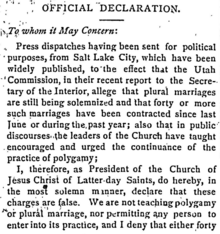 As published in the October 15, 1890 edition of the Woman's Exponent | |
| Book | Doctrine and Covenants |
|---|---|
| Category | Official declaration |
The 1890 Manifesto (also known as the Woodruff Manifesto, the Anti-polygamy Manifesto, or simply "the Manifesto") is a statement which officially advised against any future plural marriage in the Church of Jesus Christ of Latter-day Saints (LDS Church). Issued by Church President Wilford Woodruff in September 1890, the Manifesto was a response to mounting anti-polygamy pressure from the United States Congress, which by 1890 had disincorporated the church, escheated its assets to the U.S. federal government, and imprisoned many prominent polygamist Mormons. Upon its issuance, the LDS Church in conference accepted Woodruff's Manifesto as "authoritative and binding."
The Manifesto was a dramatic turning point in the history of the LDS Church. It advised church members against entering into any marriage prohibited by the law of the land,[1] and made it easier for Utah to become a U.S. state. Nevertheless, even after the Manifesto, the church quietly continued to perform a small number of plural marriages in the United States, Mexico, and Canada,[2][3] thus necessitating a Second Manifesto during U.S. congressional hearings in 1904. Though neither Manifesto dissolved existing plural marriages, plural marriage in the LDS Church gradually died by attrition during the early-to-mid 20th century. The Manifesto was canonized in the LDS Church standard works as Official Declaration 1[4][5] and is considered by mainstream Mormons to have been prompted by divine revelation (although not a revelation itself), in which Woodruff was shown that the church would be thrown into turmoil if they did not comply with it.[6] Some Mormon fundamentalists rejected the manifesto.[7]
- ^ Lyman, Edward Leo (1994), "Manifesto (Plural Marriage)", Utah History Encyclopedia, University of Utah Press, ISBN 9780874804256, archived from the original on May 30, 2023, retrieved August 15, 2024,
The Manifesto ... affirmed the church president's intention to influence fellow members to obey the law of the land.
- ^ "The Manifesto and the End of Plural Marriage". lds.org. LDS Church. Retrieved June 8, 2015.
The ledger of 'marriages and sealings performed outside the temple,' which is not comprehensive, lists 315 marriages performed between October 17, 1890, and September 8, 1903. Of the 315 marriages recorded in the ledger, research indicates that 25 (7.9%) were plural marriages and 290 were monogamous marriages (92.1%). Almost all the monogamous marriages recorded were performed in Arizona or Mexico. Of the 25 plural marriages, 18 took place in Mexico, 3 in Arizona, 2 in Utah, and 1 each in Colorado and on a boat on the Pacific Ocean.
- ^ Quinn, D. Michael (1985). "LDS Church Authority and New Plural Marriages, 1890–1904". Dialogue: A Journal of Mormon Thought. 18 (1): 9–108. doi:10.2307/45225323. JSTOR 45225323. S2CID 259871046. Archived from the original on September 25, 2015. Retrieved June 8, 2015.
- ^ Hammarberg, Melvyn (2013), The Mormon Quest for Glory: The Religious World of the Latter-Day Saints, New York: Oxford University Press, US, p. 135, ISBN 978-0-19-973762-8.
- ^ David E. Campbell, John C. Green, and J. Quin Monson (2014), Seeking the Promised Land: Mormons and American Politics, New York: Cambridge University Press, pp. 58–59, ISBN 978-1107662674.
- ^ "Polygamy: Latter-day Saints and the Practice of Plural Marriage", mormonnewsroom.org.
- ^ Krakauer, Jon (2004). Under the Banner of Heaven: A Story of Violent Faith. Knopf Doubleday Publishing Group. pp. 139, 254–255. ISBN 978-1-4000-7899-8.